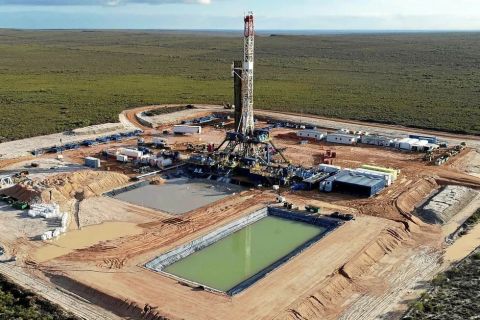In the late 1990s, the development and commercial availability of three-component (3-C) digital geophones ushered in a new era in seismic acquisition. Modern recording systems, along with the new 3-C digital sensors, made it possible to deploy and record large-scale multicomponent 3-D surveys. When combined with enhanced acquisition strategies and new processing technologies, full-wave imaging has the potential to better define reservoir rock, fluid properties and fluid movements and more accurately determine drilling locations to meet the current exploration and production challenges. While full-wave and the associated technologies are still maturing, we see hints of success in our current full-wave projects which should encourage the industry to continue to support and deploy these key technologies in the years ahead.
 Key components
Key components
The first essential element for full-wave imaging is a high-fidelity digital sensor. These advanced sensors provide four significant benefits over conventional receiver arrays:
•Extremely accurate measurements of all ground motion - both for seismic signal and for noise;
•No directional bias, making them ideal for recording azimuthal variations in seismic velocities (anisotropy);
•Freedom from intra-array statics, yielding recording of higher bandwidth, higher resolution seismic signals; and
•Easy deployability with better coupling and lower weight and bulk for improved field operational efficiency and reduced health, safety and environment (HSE) exposure.
The accumulation of sensor technology assures the acquisition specialist that the sensor will deliver the truest measure of ground motion, resulting in a clearer image of the subsurface.
With the digital sensor in place, the next step in full-wave imaging is to employ a series of enhanced field acquisition strategies in order to take full advantage of the capabilities of the new sensor. It is critical to implement wide-azimuth, long-offset survey designs to ensure an azimuthal sampling of seismic data. Acquisition systems capable of supporting high channel counts are also needed to increase spatial resolution and to image targets throughout the geologic section. Furthermore, new processing algorithms can analyze anisotropy of the earth, a property that previously has been considered noise, and can now be added to the wealth of new earth response information derived by better field methods. Anisotropy data can yield details about the subsurface like fracture orientation and stress/strain relationships, increasing the details of seismic interpretation and lowering the risk for drilling programs.
Combining these key components of full-wave imaging creates the best opportunities to date to push the commercial value of seismic data to the next level. The new data recorded from these methods will allow us to employ a wide variety of new seismic processing algorithms and interpretation techniques.
 Early returns of full-wave
Early returns of full-wave
One area of full-wave imaging which is paying early returns is in multimode data acquisition. Canada has long been recognized as an early adopter of new technology for oil and gas exploration. Basin exploration in Alberta commonly consists of seismic targets which include buried stream channels. Finding the stream channels was the first challenge to overcome, but traditional seismic techniques were able to image these types of prospects years ago. However, compressional (P) wave data alone is seldom diagnostic in determining fluid content in the targets. Multimode data shows great promise to help overcome this challenge. Moreover, enhanced P-wave seismic data can help define the boundaries of the stream channels with greater precision.
Full-wave imaging can assure that both excellent P-wave data and mode-converted data are recorded. P-wave data consists of the primary reflection energy which returns from the subsurface. Mode-converted data propagates down as a P-wave and returns as a shear wave, thus it is commonly referred to as converted-wave data. Shear-wave data propagates through the rock matrix with different properties than P-wave data. It is this difference in propagation properties which yields new information regarding the subsurface. When the two data types are combined in the interpretation, subtle differences in the reflectivity provide further clues about the rocks and in some cases the fluids that fill the pore spaces in those same rocks.
The example in Figure 1 shows a simple comparison of P-wave data on the left and converted wave data on the right from the exact same subsurface reflections. The event at 800 milliseconds represents the zone where the drilling prospect is suspected. The subtle bumps are caused by the location of the buried stream channel, so identifying the initial location is relatively easy. On the right the converted wave data reflects from the exact same horizon with slightly different properties. Although too subtle to detect in this picture, professional interpreters can extract new information which helps localize drilling targets in 3-D.
In Figure 2, the results of P-wave data and the corresponding converted wave data are shown in a map view. This is similar to looking at a horizontal slice through the earth at the prospect depth. The buried stream channel is visible on both plots, but it is the small detail differences that enhance the resolution and utility of the image. The full-wave imaging in this area has helped define new drilling targets with better accuracy, which reduces the risk of drilling.
The future
As full-wave adoption continues, there will be a demand for better processing and interpretation methods, which are just beginning to emerge. Processing algorithms that deal with multiple data sets and complex new subsurface models will greatly enhance the benefits of the technology. The combination of new hardware technology and enhanced field methods creates the opportunity to get better value for our exploration dollars.
Recommended Reading
Brett: Oil M&A Outlook is Strong, Even With Bifurcation in Valuations
2024-04-18 - Valuations across major basins are experiencing a very divergent bifurcation as value rushes back toward high-quality undeveloped properties.
Marketed: BKV Chelsea 214 Well Package in Marcellus Shale
2024-04-18 - BKV Chelsea has retained EnergyNet for the sale of a 214 non-operated well package in Bradford, Lycoming, Sullivan, Susquehanna, Tioga and Wyoming counties, Pennsylvania.
Triangle Energy, JV Set to Drill in North Perth Basin
2024-04-18 - The Booth-1 prospect is planned to be the first well in the joint venture’s —Triangle Energy, Strike Energy and New Zealand Oil and Gas — upcoming drilling campaign.
PGS, TGS Merger Clears Norwegian Authorities, UK Still Reviewing
2024-04-17 - Energy data companies PGS and TGS said their merger has received approval by Norwegian authorities and remains under review by the U.K. Competition Market Authority.
Energy Systems Group, PacificWest Solutions to Merge
2024-04-17 - Energy Systems Group and PacificWest Solutions are expanding their infrastructure and energy services offerings with the merger of the two companies.




